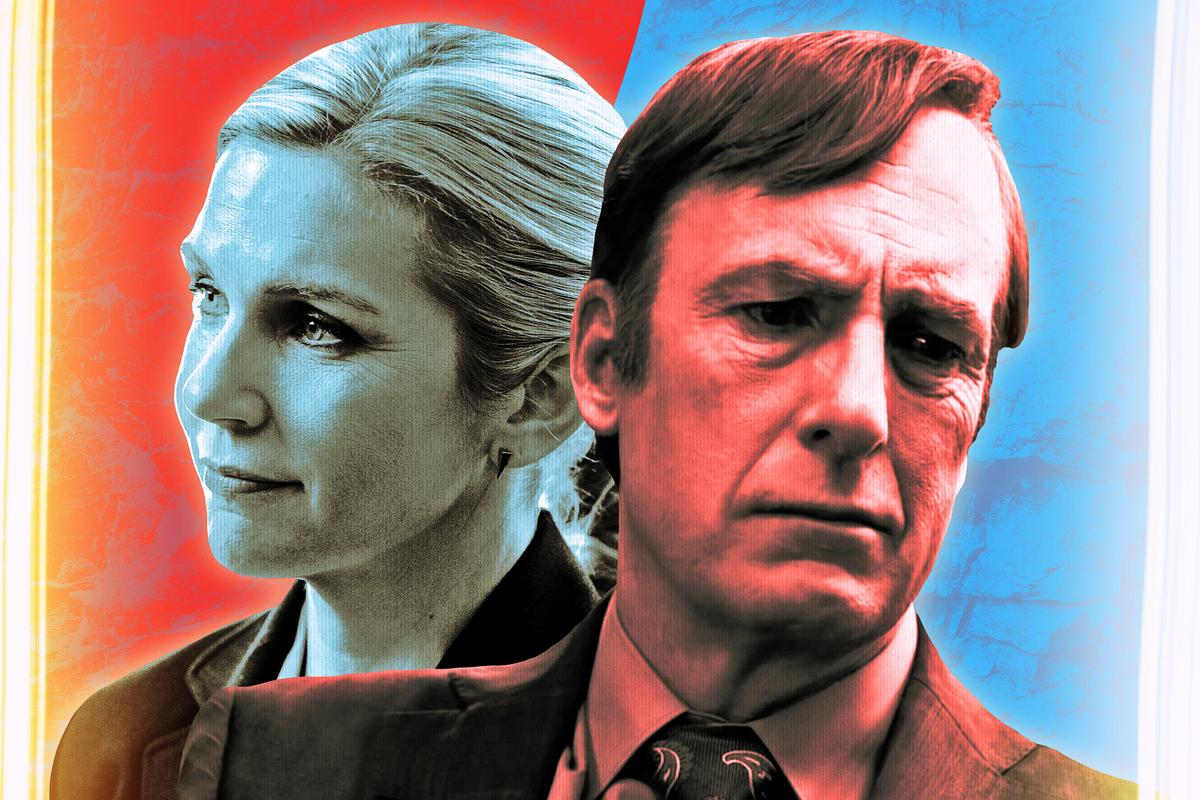How ‘Better Call Saul’ Broke the Prequel Curse
Most don’t work. The ‘Breaking Bad’ spinoff is the wonderful exception.
Among the many reasons that Better Call Saul is extraordinary is that—not to pull any punches—most prequels suck. Yes, I said it: It’s time to take prequels down a peg. Am I bitter because I was 12 when The Phantom Menace came out, the perfect age for an innocent, trusting Star Wars fan to develop a lifelong antipathy toward prequels of all kinds? Undoubtedly. But Episode I is a symptom of the ills that ail almost all prequels—and that Better Call Saul gracefully, masterfully sidesteps. We don’t yet know whether Saul’s last season will be as beloved as Breaking Bad’s, but considering its competition, we can already anoint it the best prequel ever.
One problem with prequels is that they’re rarely planned in advance. Storytellers typically start at the most interesting stage of their stories, when some kind of conflict is happening. Any TV show or movie could have a prequel, but most of them would be boring: In the prequel to North by Northwest, George Kaplan probably sits in an office and sells cigarettes, and the crop duster focuses on the corn. In the prequel to Singin’ in the Rain, it’s sunny, and there’s nothing notable about singing in the sun. In the prequel to Jaws, everyone swims safely for a while, paddles back to the beach, and towels off. (OK, one Jaws prequel concept sounds like it could’ve been good.) If whatever happened before the first episode were so interesting, the story would’ve started there instead.
Most prequels, then, come about because a piece of IP is so successful that there’s interest in making more. A spinoff series set in the same period could get in the flagship show’s way, which leaves only two temporal directions in which to extend the story: into the past, or into the future. If the nature of the original makes a sequel impossible, or some sequels already have been made, then the prequel is the path of least resistance. But because it’s grafted onto the front of an existing story after the fact, it’s often neither necessary nor a natural fit.
On top of all that, there’s the great prequel pitfall: an absence of suspense. As Stuart Henderson, author of The Hollywood Sequel: History & Form, 1911-2010, says, “There’s a central dramatic issue in that any sense of jeopardy in a prequel is undermined when we know that the characters are going on to future adventures.” That’s not to say that the only reason to listen to a story is to hear what happens next, but it helps to have that hook. A prequel must maintain some ties to the story it’s setting up; that’s what makes it a prequel. Those ties attract an audience, but they may also restrict the storyteller. If a prequel has characters in common with the IP that appeared first, then the audience knows some of what will happen to them, even if the why and how are hazy.
The move for most prequels is to flesh out the origin story of an already established character. But if that character played a prominent role in the original, then some of that backstory has probably been sketched out. The point of the Star Wars prequels was to trace Anakin Skywalker’s descent into Darth Vader, but before the prequels started, we knew most of how he got there: that he was a great pilot who was strong in the Force; that he was Obi-Wan’s friend and pupil; that he was seduced by the dark side and helped hunt down the Jedi; and that Obi-Wan bested him (and presumably left him scarred and sentenced him to decades inside his suit). With apologies to Padmé, that summary kind of covers it. With a more adept writer than the latter-day Lucas, Anakin’s tragic transformation still could’ve been cool—at times it was even with Lucas—but watching a petulant teen turn into Darth Vader just isn’t as satisfying as wondering whether one of the all-time-best bad guys will be defeated or redeemed.
For all of these reasons, prequels are far rarer than sequels. When Henderson compiled a database of prequel and sequel films for his book, he classified only 28 as pure prequels—from high-profile flicks like Red Dragon, X-Men Origins: Wolverine, Terminator Salvation, and Twin Peaks: Fire Walk With Me to bargain-bin titles that include “The Beginning” like Exorcist: The Beginning, Psycho IV: The Beginning, The Texas Chainsaw Massacre: The Beginning, and Missing in Action 2: The Beginning—compared to more than 1,200 pure sequels. Hollywood has managed several competent prequels since Henderson gathered his data (Star Trek, Rise of the Planet of the Apes, Prometheus, Monsters University, X-Men: First Class, and, depending on whether you categorize them as prequels or spinoffs, Rogue One and Solo), but the highest IMDb user rating among the prequels he counted, a so-so 7.6, belongs to 1984’s Indiana Jones and the Temple of Doom—the worst of the first three Indy films. (The Godfather: Part II comes in at 9.0, but it’s as much a sequel as it is a prequel.)
When Better Call Saul was announced, it wasn’t exempt from the usual prequel concerns. The best thing it had going for it was that it was developed by the talented Vince Gilligan and Peter Gould, creator and producer, respectively, of Breaking Bad. If that duo could make one great show together, why not another? But that pedigree put the pressure on, especially because Breaking Bad had recently engineered one of the most acclaimed endings ever, which seemed to set up Saul for a dispiriting debut. “Prequels only tend to get made to bigger franchises/properties, or at least longer-running series of films, which adds to the level of expectation—and therefore increases the potential for disappointment,” Henderson says.
As current cohost of The Watch Andy Greenwald wrote at Grantland in July 2014, “I am dreading this show and I think it’s an awful idea.” As Andy acknowledged, he was down on the idea of the show; the first season itself was still seven months away (and when it arrived, he praised it). There was every reason to be skeptical of the concept, because the concept was a prequel. And as we’ve established, most prequels suck.
Because Breaking Bad left so few loose ends, a sequel series wasn’t an option. Walt, Hank, Mike, and Gustavo were dead, and Jesse’s escape to Alaska offered only one movie’s worth of material, which eventually became El Camino. Aside from Skyler and Flynn’s adventures in carwashing, web design, and cereal consumption—or Saul’s Cinnabon franchise—there was nowhere to turn except the past.
Initially, Gilligan sounded about as excited about the prospect of keeping Breaking Bad’s Albuquerque crew employed as he did about explaining Saul’s origins, and Gould has said that Jimmy was originally supposed to take his new name as soon as Season 1. It would have been easy for the creative team to commit the common mistake of making a prequel all about charting a previous protagonist or antagonist’s path to the point where he was when we met him: younger Gus, or even younger Walt. Even after Saul was cemented as the lead, Gould kept open the possibility that the series could overlap with Breaking Bad and feature cameos from Bryan Cranston and Aaron Paul. But the sleazy lawyer played by Bob Odenkirk, who debuted in Breaking Bad’s second season, soon put his stamp on the prequel.
Of setting a second series in Albuquerque, Andy wrote pre-premiere, “Going back to the scene of the crime reeks of hubris and/or foolishness. Probably both.” But the sense of Breaking Bad continuity supplied by that familiar physical landscape gave the show the freedom to find its own tone. Although Saul didn’t stick to a half-hour sitcom format, as originally planned, its full-hour episodes hewed closer to a sitcom style, shaking up Breaking Bad’s comedy/drama balance in favor of the former. In place of cooking, it has conning and court. Saul was more meandering and slower-paced—perhaps too slow and low-stakes at times. For most of its run, that formula has made Saul more of a character study than a plot-driven thrill ride.
Crucially, the characters it studied weren’t all familiar faces. New additions, like Chuck (Michael McKean), Kim (Rhea Seehorn), and, lately, Lalo (Tony Dalton), whose fates aren’t yet determined, have allowed us to forecast and conjecture as much as we did with Walt and Jesse.
The series still tantalizes with flash-forward looks at Saul’s post–Breaking Bad life, and for those who like making connections to the older Saul’s series, cameos and Easter eggs abound. Personally, I prefer less time with Tuco and more time with Kim at Tucumcari, the partner in law who’s become a partner in crime both literally and colloquially. On its own, we could predict the progression of Jimmy/Saul’s degeneracy, which would rob it of much of its emotional heft. It’s exponentially more agonizing when juxtaposed with Kim, the cipher who has fed (and fed on) the flaws of her unlikely, corrupted companion.
As my colleague Miles Surrey wrote at the start of Season 5, “Walter White’s five-season transformation into Heisenberg feels like a show peeling the presentable layers off a monster, Jimmy’s fate feels like the result of hundreds of little moments and compromises that build into a new identity. Walt was always Heisenberg; becoming Saul Goodman took a lifetime of bad decisions and negative experiences.” It’s felt like a lifetime, but I’m happy to linger a little longer in Albuquerque, Nebraska, or wherever Gilligan and Gould desire.
Saul’s not-so-secret sauce is its writing, producing, acting, and cinematography. It’s hard enough to pick the proper prequel blueprint; it’s more difficult still to assemble a cast and crew so talented that every line comes alive. Some of what Saul does can be copied—like creating compelling new characters, tinkering with tone and genre, and not naming it Breaking Bad: The Beginning—but the presence of Gilligan, Gould, Odenkirk, Seehorn, and so many other essential supporting parties isn’t really replicable.
Pointing out the sweeping problems with prequels as a group only elevates the few standouts, and no prequel has pulled farther apart from the pack than Saul. In summary: Stop making most prequels. They’ll never be Better Call Saul.

